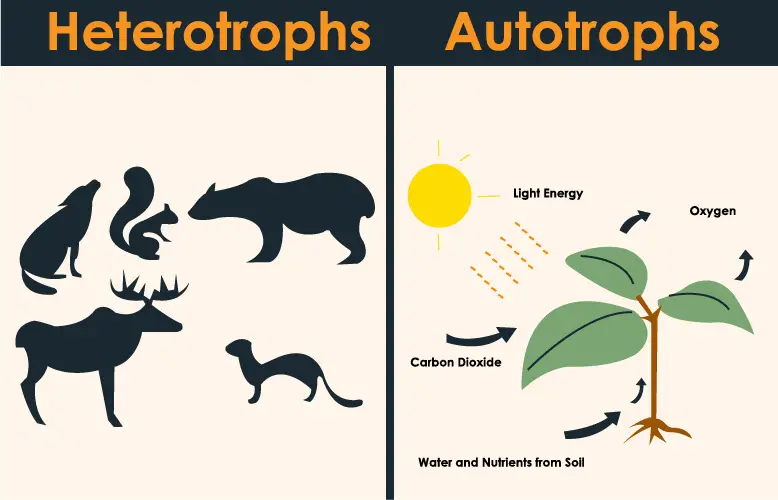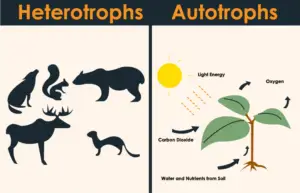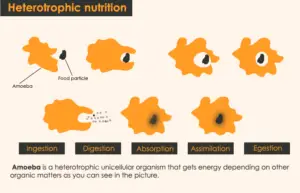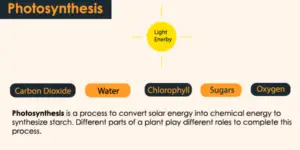
Autotroph vs Heterotroph Some Interesting Basic Differences Between Them.
An autotroph is a creature category that is able to manufacture its food by itself (opposite of heterotroph), while heterotroph (opposite of autotroph) is an opposite creature category that is not able to manufacture its food itself and somehow rely on autotrophs.
Food is the only energy source on planet earth that organisms acquire to fulfill their nutritional needs. Organisms can be categorized on the basis of nutritional modes they use to acquire energy.
check: Yeast and Mold Difference Comparison Guide.
This is a quite simple overview. Without wasting time now let’s have a look at differences that exist in autotroph vs heterotroph.

Differences between autotroph and heterotroph
| Autotrophs | Heterotrophs | |
| 1. | These are able to produce/ manufacture the food of their own. | These are not able to manufacture the food of their own and depend on other organisms for nutritional needs.
|
| 2. | These are divide into two sub-types which are as photoautotrophs and chemoautotrophs. | These are also sub-divided into two which are as photoheterotrophs and chemoheterotrophs. |
| 3. | These include green plants, photosynthetic bacteria, and algae. | These include animals such as monkey, humans, sheep, buffalo, tiger, alligator, and bear. |
| 4. | The chloroplast is the major thing that help in preparing food. | Chloroplast is absent so these are not able to manufacture their own food. |
| 5. | They are not able to locomote which means they are not able to move from one place to another | As they are fully able to locomote as they possess fully developed skeletal system. |
| 6. | These are considered at the primary level of the food chain. | These are considered at the secondary level or tertiary level of the food chain. |
| 7. | These acquire energy from the inorganic sources of food as by transforming light into chemical energy. | These acquire energy from other organisms by directly or indirectly relying on them as by feeding on other animals and plants. |
| 8. | These are able to store light and chemical energy. | These are really not able to store energy. |
Also read: reptiles vs amphibians distinctions and comparison
Are animals autotrophs or heterotrophs? They are heterotrophs because they are not able to make their food/nutrition on their own as plants do by utilizing sunlight to carry photosynthesis. In fact, animals depend on organic matters which are mostly plants or other animals. Humans are th best example of heterotrophs as they are omnivores dependent on almost all categories of organisms.
Watch a video first related to autotroph vs heterotroph:
What are Heterotrophs?
Heterotrophs are animals or organisms that are producer dependents. These are animals which are not be able to produce food of their own and depend on producer organisms like green plants and other animals for their food needs.
OR
Organisms that cannot make their own food and must obtain energy from external sources are called heterotrophs

In simple words, heterotrophs are autotroph dependent organisms. These are considered consumers as they consume other organisms to supply continuous nutrition to their body.
As heterotrophs are autotroph dependent so they get benefit from them in multiple ways as:
- As herbivores consume plants.
- Consuming O2 for the cellular respiration.
- Directly or indirectly by preying on other animals for meat.
Types of heterotrophs:
There are major 5 types of heterotrophs that exist which are carnivores, herbivores, omnivores, decomposers, and detrivores.
- Carnivores: These are organisms that eat/rely on the meat of other organisms or rely on herbivores for instance lion, tiger, cheetah, and eagle.
- Herbivores: These are organisms that rely on herbs & plants for example deer, goat, and camel.
- Omnivores: These are organisms that can rely on either herbs or other animal meat, in simple words these can be carnivores and herbivores at the same time for instance humans.
- Detrivores/Scavengers: Organisms that rely on waste material of other organisms including plants & animals. Detrivores’ examples include dung flies, woodlice, and crabs.
- Decomposers: Organisms that rely on dead organic matter, for instance, dead plants & animals, examples of decomposers include mushrooms, earthworms, beetle, slug, slime mold, yeast, saprobe and millipede.
List of Heterotrophs:
There is a vast list of heterotrophs but few if them are as follow:
- Lion, tiger, cheetah, hyenas, and all big cats.
- Deer, Camel, zebra, giraffe, buffaloe, goat, and all green/herb eating animals.
- Sparrow, crow, parrots, eagle, and all birds.
- Cockroach, ants, beetle, wasp, bees, and all insects.
- Aligator, snake, turtle, and all reptiles.
- frog, sea elephant, and all amphibians.
What are Chemotroph Organisms? Chemotrophs can be autotrophs or heterotrophs. These are organisms that utilize the oxidation process to acquire energy from electron donors in their environment. These are in the distinction to phototrophs as plants or photosynthetis bacteria ae phototrophs. Chemotrophs are usually found on the extreme depths of ocean and in volcanos.
What are Autotrophs?
Autotrophs are organisms that are highly able to prepare their own food by using simple substances like water, and carbon dioxide. These organisms consider autotrophic nutritional mode. These include all green plants and photosynthetic bacteria.

These consider the photosynthesis that includes the carbon fixation by carbohydrate conversion which include glucose, cellulose, sucrose, amylopectin, and starches.
Carbohydrates are considered interconvertible, as they may transform into fatty acids and ultimately to lipids. To manufacture carbohydrates as energy source there may be certain things added as protein. Lipids, proteins, and carbohydrates are common in both autotrophs and heterotrophs as energy sources
Are herbivores autotrophs or heterotrophs? Herbivores are heterotrophs as they rely on plants and other green herbs and can’t produce their own food. On the other hand the greens that are eaten by herbivores are autotrophs because they are able to produce their own food by using photosynthesis in the presence of light energy.
Types of Autotrophs:
There are two vital 2 types of autotrophs that exist are Chemotrophs & Photoautotrophs.
Chemotrophs: Organisms that feed on the energy they get from electron donors in their environment through the oxidation process.
Photoautotrophs: Organisms that feed on the energy they make their own selves by utilizing light energy in cooperation with carbon dioxide.
list of Autotrophs:
Autotrophs do also possess an extremely vast list of species but the main from them are listed as follow:
- Plants
- bacteria
- ALgae
- Seaweed
- Phytoplankton
What is another name for autotroph? Another title that can be used for an autotroph is a producer, this is because of the ability it has of making its food on its own while depending not on other organisms.
What is a photoautotroph energy source?
Phototrophs are those organisms that carry out photosynthesis utilizing the sunlight and yield energy as a result. The energy source like sun or sunlight is known as photoautotroph energy source.
Autotrophs and Heterotrophs similarities
Similarities between autotrophs and heterotrophs are very simple as follow:
- They both are living organisms
- Both required energy to survive in the ecosystem.
- Both are very crucial ecosystem parts, with the absence of any of them can create gian problem to the ecosystem.
- Both need Oxygen and light energy to survive.
- There is Autotrophic and heterotrophic bacteria which can also be a similarity.
How do autotrophs and heterotrophs differ? Both differ in their food consumption behavior, as autotrophic organisms make food on their own using sunlight, while heterotrophs depend on other organisms (either on plants or other heterotrophic animals) to consume food by killing them.
Conclusion:
This is a very basic comparison overview of the similarities and differences between autotrophs and heterotrophs. We can conclude that both these are two different organism categories but at the same time, they both are equally very much important to the ecosystem for the ecosystem to retain in nature. As they highly required energy to live, similarly the ecosystem requires them to exist properly in nature.
You may also enjoy reading:
- Simple vs Compound Leaves Differences and Comparison (Short Coffee Read)
- Difference Between Hibernation and Estivation / Aestivation (with video)
- Mitochondria and Chloroplast, Difference And Comparison Guide